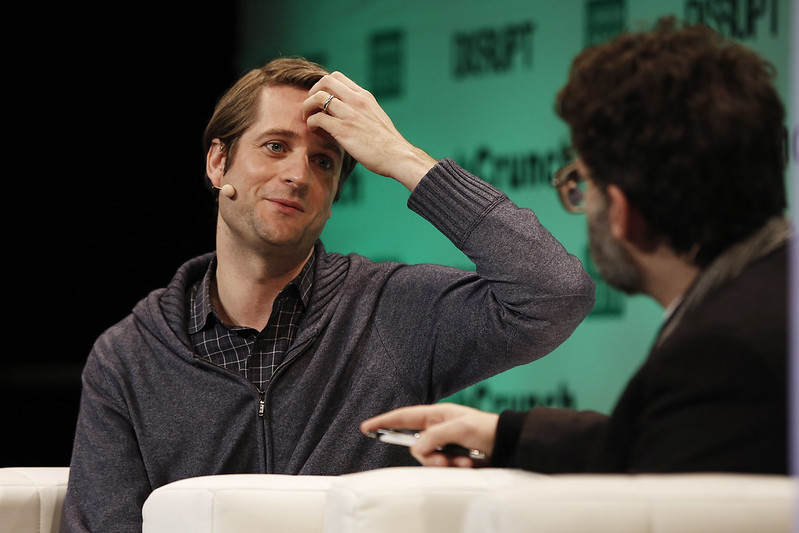 Co-founder and CEO Klarna Sebastian Siemiatkowski and Jonathan Shieber during TechCrunch Disrupt London 2015 - Day 1 at Copper Box Arena on December 7, 2015 in London, England. (Photo by John Phillips/Getty Images for TechCrunch)
Co-founder and CEO Klarna Sebastian Siemiatkowski and Jonathan Shieber during TechCrunch Disrupt London 2015 - Day 1 at Copper Box Arena on December 7, 2015 in London, England. (Photo by John Phillips/Getty Images for TechCrunch)
There's an abbreviation for companies that allow people to buy something instantly and pay later: BNPL: buy now, pay later.
The tech selloff has made a mess of the fintech sector. BNPL rival Affirm’s (AFRM.O) share price has dropped 76% since January, leaving a market capitalisation of $6.9 billion. Fellow payments company Block (SQ.N) – led by Jack Dorsey – has dropped 48%.
The BNPL sector is struggling. Afterpay, acquired by Block for $32 billion, saw bad debts balloon to $177 million in the six months to December, from $72.1 million a year ago. True, entering new markets partly explains why. But fashion retailers such as Asos (ASOS.L), which partially rely on BNPL to increase sales, have also seen increasingly cash-strapped punters buying less. Meanwhile, in 2021, Klarna made an operating loss that was triple the one recorded in 2020.1
Yesterday, very soon after Klarna's evaluation dropped from 46 billion USD (June 2021) to roughly 30 billion USD, the CEO announced—via prerecorded video message—that Klarna will fire around 10% of its staff, around 700 people.
Klarna reported operating losses of 6.58 billion Swedish crowns ($689 million) in 2021.
Sebastian Siemiatkowski, Klarna's CEO, has accrued personal wealth in the realm of 28 billion Swedish crowns (around 2.8 billion USD). He could personally pay Klarna's operating 2021 loss for four years and live well off the interest that his remaining wealth would generate. Mind you, he's not the wealthiest Klarna c-level person.
Just imagine what world problems could be solved by the wealthiest persons at the top of Sweden's most current answer to WeWork.
In 2021, Siemiatkowski bragged that part of Klarna's success is because of financing via savings accounts and the fact that Klarna pays lower interest rates than a major bank like Crédit Agricole. This is due to the fact that Sweden has a higher credit score than France.
The average purchase via Klarna is 75 USD. In 2020 and 2021, Klarna sent 72,000 payment injunctions to the Swedish Enforcement Authority. This means 72,000 payments were not met in time.
The best customer is the one that doesn't pay at once, but gets a reminder and then a debt collection claim.
Niklas Adalberth, Klarna founder, at an investment conference in 2014.
In 2020, the record number of Swedes who'd applied for debt relief was broken. The problem was particularly big for people between 18 and 30 years old.
In other words, BNPL companies trap young people in debt; now, ironically enough, the future has come for Klarna and their ilk to pay.
After the layoffs, Swedish TV has reported that Klarna have asked five out of eight union representatives to resign.2 This could be coincidence, but it's worth to note that Klarna have repeatedly avoided engagement with unions, for which there's strong support in Sweden. Klarna did not let Swedish unions know about the coming layoffs before they happened, something that is considered good practice in Sweden.
According to Klarna's Q1 2022 report, their income increased by 20%. Their main problem is, their costs also increased, three times as fast as their income. Their loss is 2.6 billion Swedish crowns (approximately 260 million USD) in three months. That's 340,000 USD per hour. Bankruptcy is close.3
The borrowing construct is introducing real risk into the system: Consumer debt jumped $52 billion in March, the largest increase on record. In California, 91 percent of consumer loans made in 2020 were BNPL loans. More than 40 percent of Gen-Z consumers will have used BNPL by the end of the year, the highest penetration of any age group. And now those debts are going bad.
[...]
Even if it isn’t the triggering event of a global crisis, the evisceration of the finances of a generation will suppress innovation and economic growth. Western capitalism once fueled the greatest increase in prosperity in history, giving us technological advances that would have seemed like magic a few generations ago. What are we doing with that abundance? Engineering ever more insidious ways to get young people to buy disposable clothes. Torched credit ratings and mounting debt deter people from starting families and businesses. Those are the building blocks of our society and economy, and without them, we will all pay later.4
-
Kwok, Karen. 2022. “Klarna’s $46 Bln Price Tag Endures Only In Theory.” Reuters . May 19, 2022. https://www.reuters.com/breakingviews/klarnas-46-bln-price-tag-endures-only-theory-2022-05-19/. ↩
-
Kainz Rognerud, Knut. 2022. “Klarna Vill Bli Av Med Fackligt Aktiva – Uppmanas Att Säga Upp Sig.” SVT Nyheter. May 24, 2022. https://www.svt.se/nyheter/inrikes/klarna-vill-bli-av-med-fackligt-aktiva-uppmanas-att-saga-upp-sig. ↩
-
Cervenka, Andreas. 2022. “Klarna Blöder Tre Miljoner I Timmen – Verkligheten Har Hunnit Ikapp.” Aftonbladet. May 24, 2022. https://www.aftonbladet.se/nyheter/kolumnister/a/x8jgv8/andreas-cervenka-verkligheten-har-hunnit-ikapp-klarna-kry-trustly-och-storytel. ↩
-
Galloway, Scott. 2022. “Buy Now. Pay (and Pay, And Pay, And Pay) Later.” Intelligencer. May 23, 2022. https://nymag.com/intelligencer/2022/05/buy-now-pay-later-is-coming-due-for-all-of-us.html. ↩